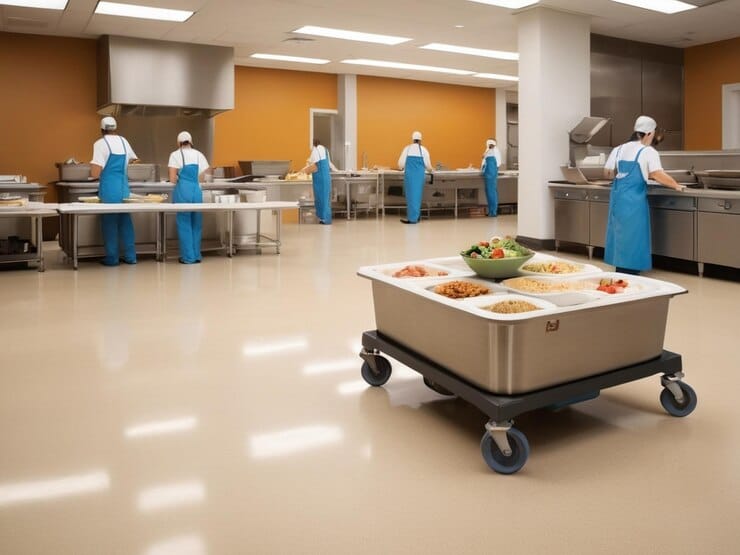
Establishing a semi-fried potato factory is an important strategic step in the food industry sector.
The demand for fast and frozen food products is increasing with the increasing burdens of daily life. Half-fried potatoes are at the top of the list of these products, as they represent a preferred choice for consumers looking for a product that is easy to prepare and delicious at the same time.
The importance of a semi-fried potatoes in the market
Global and local markets are witnessing a continuous growth in demand for half-fried potatoes, due to their ease of preparation and diverse use in many dishes. Half-fried potatoes are a major product in the frozen food sector, as they are widely consumed by individuals, restaurants and food establishments. This product is characterized by its long shelf life and ease of storage, making it an economical and suitable option for different consumer categories.
Basic steps to establish a semi-fried potato factory
1- Choosing the right location
Choosing the ideal location to establishing a semi-fried potato factory is one of the most important steps that must be focused on. The site must be close to sources of raw materials such as potato farms, as well as close to major markets to facilitate distribution operations. The site must also have a strong infrastructure including paved roads, stable water and electricity sources.
2- Purchasing modern equipment and technologies
Establishing a semi-fried potato factory requires the use of advanced equipment to ensure the quality of the final product. Basic equipment includes potato peeling, cutting, partial frying, freezing and packaging lines. The cost of this equipment can vary depending on the production capacity and technologies used, so it is necessary to choose modern technologies that provide production efficiency and reduce energy consumption.
3- Securing raw materials
Potatoes are the main element in the production process, so reliable sources from high-quality potato farms must be secured. It is also necessary to conclude long-term agreements with suppliers to ensure uninterrupted production. In addition, it must be ensured that the crop meets the required standards in terms of size, texture, and taste.
4- Adherence to health and quality standards
Quality, health, and safety standards are crucial in the food industry. The factory must adhere to all health requirements in force in the country, including the ISO quality management system, and food safety certificates such as HACCP. Adherence to these standards enhances consumer confidence in the final product and increases the chances of the factory’s success in local and international markets.
Benefits of having a semi-fried potato factory in the market
1- Meeting the growing demand
Establishing a semi-fried potato factory is an important step to meet the growing demand for this product in the market. With the increase in local and international consumption rates, the need for fast-cooked food products is increasing, which enhances the chances of success of this project.
2- Strengthening the local economy
Establishing a semi-fried potato factory contributes to strengthening the local economy by providing new job opportunities, whether in the field of production or distribution. It also contributes to improving the value chain of local agricultural products, which enhances farmers’ income and contributes to the development of the agricultural sector.
3- Supporting innovation in the food industry
By investing in modern technologies and manufacturing innovative products, the semi-fried potato plant can become a center of innovation in the food industry. This can lead to improved products and new options for consumers, which enhances the plant’s ability to compete in the market.
How to make semi-fried potatoes and their production line
The process of making semi-fried potatoes is a multi-stage process, starting from receiving the raw materials and ending with packaging the final product. To ensure obtaining a high-quality product that meets consumers’ expectations, it is necessary to follow precise and accurate production steps, and to use modern equipment that ensures preserving the flavor and texture of the potatoes. The following is a detailed explanation of the semi-fried potato production line
1- Receiving raw materials and initial preparation
First, potatoes are received from approved suppliers after ensuring their quality and compliance with the required standards. The potato sorting process is carried out to ensure that they are free of any defects such as spots or deformities. After sorting, the washing process begins using advanced systems that remove dust and impurities from the surface of the potatoes. Clean and sterile water is used during this stage to ensure the highest levels of cleanliness.
2- Peeling and cutting
After the washing process, the potatoes move to the peeling stage, where the outer peel is removed using automatic peeling devices that operate in a precise manner that prevents the loss of a large part of the potato pulp. This part of the process is sensitive because any remnants of the peel can affect the quality of the final product.
Once peeling is complete, the cutting stage comes, where the potatoes are cut into uniformly sized slices or fingers, according to the specifications of the final product. This process is done using precise cutting machines that ensure equal pieces, which contributes to even cooking later.
3- Soaking potatoes in a special solution
After cutting, the potatoes are transferred to the soaking stage in a special solution containing ingredients such as ascorbic acid or citric acid. This solution helps prevent oxidation of the potatoes, which preserves their natural color and prevents them from turning brown. Soaking also contributes to improving the flavor of the potatoes and their stability during cooking.
4- Blanching and Par-frying
After soaking, the potatoes move to the primary frying stage, which is a key step in the manufacture of semi-fried potatoes. In this stage, the potatoes are immersed in pure vegetable oil at a high temperature, usually between 160-180 degrees Celsius, for only a few minutes. This partial frying (Par-frying) gives the potatoes a partially crunchy texture and starts the cooking process, without the potatoes being fully cooked. The goal of this stage is to stabilize the starch and develop the outer texture, while keeping the inside soft and receptive to the final flavor that will be added when the final frying is done at home or in the restaurant.
5- Filtering and rapid cooling
After frying, the potatoes are filtered from excess oil using filtering systems that rely on vibration or compressed air. This step is important to ensure that the final product does not contain excess amounts of oil, which enhances the quality of the potatoes and makes them healthier.
After filtering, comes the rapid cooling stage, where the potatoes are quickly cooled to a low temperature to prevent the continued cooking process, which can lead to the loss of the ideal texture. In this stage, cold air is used to pump through the potatoes to quickly and effectively reduce their temperature.
6- Rapid freezing
The rapid freezing process is one of the most important stages of production, as the potatoes are quickly frozen at very low temperatures (up to -40 degrees Celsius) using the Individual Quick Freezing (IQF) technology. This technology ensures that each piece of potato is frozen separately, preventing them from sticking to each other and maintaining their high quality. Rapid freezing also helps to preserve the flavour, texture and nutritional value of potatoes.
7- Packaging
After freezing, potatoes are transferred to the packaging stage. The semi-fried potatoes are packed in airtight containers designed to preserve the product during storage and transportation. Moisture-resistant and airtight plastic containers are often used with the possibility of printing product information such as production date, expiration date and nutritional information.
8- Storage and Distribution
The semi-fried potatoes are stored in refrigerated warehouses at a temperature between -18 and -20 degrees Celsius to ensure that the product remains fresh and usable for a long period of up to several months. The product is then distributed to various points of sale, whether retail stores, restaurants or other food companies.
In conclusion, establishing a semi-fried potato factory is a promising project that requires careful planning and thoughtful investments. By focusing on quality, adhering to health standards, and adopting effective marketing strategies, this project can become successful and profitable in the long run. If you are planning to start or improve this project, you can seek the expertise of ProNano Food Industry Consulting Company, as the company provides specialized consulting services to help you implement and develop your project successfully. Contact us
To learn more details, read about establishing factories and managing food projects



